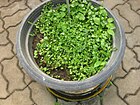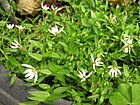Note: This is a project under development. The articles on this wiki are just being initiated and broadly incomplete. You can Help creating new pages.
Lobelia chinensis
Lobelia chinensis is a creeping or decumbent perennial plant with slender, branched stems that root at their lower nodes. The plant forms a clump of growth 6 - 30cm tall. Although poisonous, this plant is often used in Chinese herbal medicine. It is frequently harvested from the wild and is traded in local markets.
Contents
- 1 Uses
- 2 Parts Used
- 3 Chemical Composition
- 4 Common names
- 5 Properties
- 6 Habit
- 7 Identification
- 8 List of Ayurvedic medicine in which the herb is used
- 9 Where to get the saplings
- 10 Mode of Propagation
- 11 How to plant/cultivate
- 12 Commonly seen growing in areas
- 13 Photo Gallery
- 14 References
- 15 External Links
Uses
Tuberculosis, Asthma, Bloody vomiting, Lower the blood pressure, Stop bleeding, Swellings, Sores, Tooth abscesses, Traumatic injuries, Kidney problems.[1]
Parts Used
Chemical Composition
The structure of lobechine (1) was comprehensively established with the aid of 1D and 2D NMR spectroscopic analyses.[2]
Common names
| Language | Common name |
|---|---|
| Kannada | |
| Hindi | |
| Malayalam | |
| Tamil | |
| Telugu | |
| Marathi | |
| Gujarathi | |
| Punjabi | |
| Kashmiri | |
| Sanskrit | |
| English |
Properties
Reference: Dravya - Substance, Rasa - Taste, Guna - Qualities, Veerya - Potency, Vipaka - Post-digesion effect, Karma - Pharmacological activity, Prabhava - Therepeutics.
Dravya
Rasa
Guna
Veerya
Vipaka
Karma
Prabhava
Habit
Identification
Leaf
| Kind | Shape | Feature |
|---|---|---|
Flower
| Type | Size | Color and composition | Stamen | More information |
|---|---|---|---|---|
| {{{5}}} |
Fruit
| Type | Size | Mass | Appearance | Seeds | More information |
|---|---|---|---|---|---|
Other features
List of Ayurvedic medicine in which the herb is used
Where to get the saplings
Mode of Propagation
Seeds, Basal cuttings in the doemant season.
How to plant/cultivate
At least in Malaysia, this species propagates mainly by vegetative means.[4]
Commonly seen growing in areas
Wet places, Especially around paddy fields, Grassy localities, Along water courses, On cultivated land.
Photo Gallery
References
External Links
- Ayurvedic Herbs known to be helpful to treat Tuberculosis
- Ayurvedic Herbs known to be helpful to treat Asthma
- Ayurvedic Herbs known to be helpful to treat Bloody vomiting
- Ayurvedic Herbs known to be helpful to treat Lower the blood pressure
- Ayurvedic Herbs known to be helpful to treat Stop bleeding
- Ayurvedic Herbs known to be helpful to treat Swellings
- Ayurvedic Herbs known to be helpful to treat Sores
- Ayurvedic Herbs known to be helpful to treat Tooth abscesses
- Ayurvedic Herbs known to be helpful to treat Traumatic injuries
- Ayurvedic Herbs known to be helpful to treat Kidney problems
- Herbs with Whole plant used in medicine
- Habit - Perennial
- Index of Plants which can be propagated by Seeds
- Index of Plants which can be propagated by Basal cuttings in the doemant season
- Herbs that are commonly seen in the region of Wet places
- Herbs that are commonly seen in the region of Especially around paddy fields
- Herbs that are commonly seen in the region of Grassy localities
- Herbs that are commonly seen in the region of Along water courses
- Herbs that are commonly seen in the region of On cultivated land
- Herbs
- Pages without herbs images






